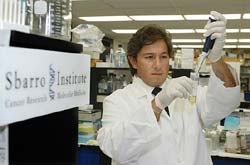Life Sciences and Chemistry
Articles and reports from the Life Sciences and chemistry area deal with applied and basic research into modern biology, chemistry and human medicine.
Valuable information can be found on a range of life sciences fields including bacteriology, biochemistry, bionics, bioinformatics, biophysics, biotechnology, genetics, geobotany, human biology, marine biology, microbiology, molecular biology, cellular biology, zoology, bioinorganic chemistry, microchemistry and environmental chemistry.

Cyclacel and MRC geneservice set to distribute Drosophila RNAi set
Cyclacel Limited, the UK-based biopharmaceutical company, announced today that it had entered into an agreement with MRC geneservice for the distribution of its proprietary Drosophila RNA interference (RNAi) collection. This agreement will allow access for MRC geneservice’s academic and commercial clients to the Cyclacel collection, for gene identification and validation purposes.
The Cyclacel Drosophila RNAi set covers some 13,605 genes defined in the FlyBase Drosophila genome database. The

Temple study identifies molecular mechanisms that may assist gene in blocking lung cancer
The molecular mechanisms that may assist the tumor suppressing gene Rb2/p130 in blocking the progression of lung cancer cells has been clearly identified for the first time according to a study by researchers at Temple University’s Sbarro Institute for Cancer Research and Molecular Medicine.
The results of their study, “pRb2/p130 target genes in non-small cell lung cancer cells identified by microarray analysis,” appear in the Oct. 9 issue of Oncogene (http://www.nature.com/onc/).

Sleep boosts ability to learn language, University of Chicago researchers find
Scientists at the University of Chicago have demonstrated that sleeping has an important and previously unrecognized impact on improving people’s ability to learn language.
Researchers find that ability of students to retain knowledge about words is improved by sleep, even when the students seemed to forget some of what they learned during the day before the next night’s sleep. This paper, “Consolidation During Sleep of Perceptual Learning of Spoken Language,” is being published i

Use eggs, not embryos, to derive stem cells, say researchers
Concerns about the ethics of using embryos created to treat infertile couples for stem cell research is discussed by researchers at St Mary’s Hospital, Manchester in this week’s BMJ.
Although the Human Fertilisation and Embryology Act 1990 allows the creation of embryos for research in the United Kingdom, the House of Lords Select Committee on stem cell research reported in February 2002 that embryos should not be created unless there is a demonstrable and exceptional need that cannot be met

’Genetic switch’ proves two mechanisms exist by which immune system cells differentiate
The thymus, a once overlooked glandular structure just behind the top of the sternum, has gained increasing attention from scientists in the past two decades because it is where disease-fighting T-cells mature.
Especially in AIDS patients, T-cell count is a relative indicator of the body’s ability to fight disease. Until recently, however, researchers have understood little about how T-cells are generated.
Now, thanks to what a researcher at the University of Georgia calls a

How Genes Orchestrate Facial Expressions
Humans Share DNA That Helps Mice Move Ears, Eyes, Whiskers
University of Utah researchers have identified genes that ensure nerves develop in the correct part of the brain so mice can roll their eyeballs sideways, wiggle their whiskers, pull their ears back and blink their eyelids. The genes are common to all mammals, and so they likely help control human facial expressions such as smiles and frowns.
“In this study we looked at what nerves are made in a particular part of th